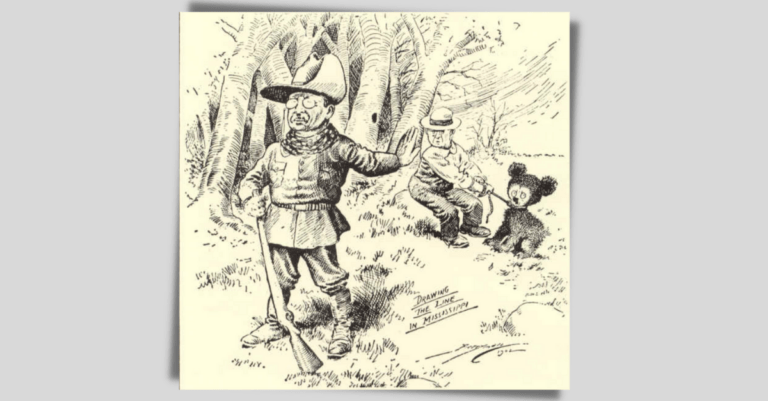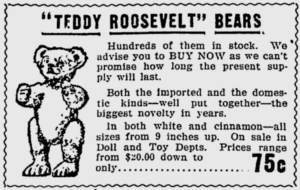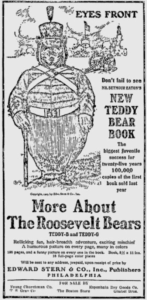- Teddy Roosevelt refused to shoot a bear on a hunting trip.
- A Brooklyn, NY, company heard the story and made stuffed “Teddy’s bears.”
- A German company also made stuffed bears that were imported by another company as Teddy bears.
- Teddy bears became a craze.
Teddy bears got their name from a story about Theodore Roosevelt and a failed bear-hunting trip. See the 1902 Washington Post cartoon that started a teddy bear craze.
Have you ever wondered how teddy bears got their name?
The story goes that in 1902, the US president, Teddy Roosevelt, went to the South to settle a border dispute between Mississippi and Louisiana, and while he was there, he went on a bear hunt.
The hunting wasn’t going so well, and the organizers wanted the president to be happy, so they captured a bear for him and tied it up. When Roosevelt arrived, they presented him with the poor trussed up bear, suggesting that he shoot it. Roosevelt thought this was quite unsporting and refused.
Here the story gets murky. I’ve read accounts that Roosevelt demanded the bear be freed, and I’ve also read accounts that Roosevelt suggested that someone else shoot the bear and put it out of its misery. Either way, the story of Roosevelt refusing to shoot the bear got out, and the Pulitzer-Prize-winning cartoonist Clifford Kennedy Berryman drew a cartoon for The Washington Post depicting an aloof and merciful Teddy refusing to shoot a cute, frightened little bear. As a double play, the illustration was titled “Drawing the Line in Mississippi,” referring to both Roosevelt being in town because of the border dispute and to his drawing a moral line at not shooting a helpless, captive bear.
Berryman’s cartoon was syndicated around the country and people loved it. That positive reception inspired the Michtoms, Russian immigrants who lived in Brooklyn, to make a stuffed bear cub they called “Teddy’s bear” and to put it in their store window. Their first bear was so popular that they created the Ideal Novelty and Toy Company to make more.
Around the same time, a company in Germany called Steiff also began manufacturing stuffed bears, very likely without any knowledge of the Roosevelt-inspired production that was taking place in the US, and in 1903 a New York toy buyer bought 3,000 of the German bears to bring to the US.
Now two companies were selling Teddy bears, and the toys became something of a craze. A 1906 citation from the Oxford English Dictionary shows a line from “American Stationer” that reads “Probably no novelty of recent years has been so popular as the Teddy Bears.”
Image: 1907 Pittsburgh Press
I found newspaper ads from 1907 advertising “Teddy Roosevelt Bears” and for a series of spin-out books called “The Roosevelt Bears,” which featured Teddy G (a good bear) and Teddy B (a bad bear). Two bears with the same names were presented to the Bronx Zoo. There was a rush of teddy bear songs such as “The Teddy Bear March and Two Step,” and manufacturers made all kinds of teddy bear products including tea sets, cages for stuffed bears, paper dolls, scarf pins, and so on.
Back then, teddy was capitalized because it was the president’s nickname, but sometime over the years, it became acceptable to write “teddy bear” lowercase, and that’s how Merriam-Webster’s online dictionary and the Oxford English Dictionary list it today.
The next time you see a teddy bear, remember Theodore Roosevelt and his failed hunting trip.
Image: 1906 Milwaukee Journal.
Image: 1907 Milwaukee Journal.
Sources
Clay, M. “The History of the Teddy Bear.” Teddy Bear & Friends website. 2009. (accessed January 23, 2023).
Porterfield, W.R. “Here’s Where All Those Teddy Bears Came From,” The Milwaukee Journal. Friday, May 21, 1971.
Sorel, N. Word People. American Heritage Press: New York. 1970. p. 281.
“teddy bear.” Merriam-Webster online dictionary. (accessed January 23, 2023).
“teddy bear.” Oxford English Dictionary online edition. (subscription required, accessed January 23, 2023).
“Teddy Bears.” America’s Story from America’s Library website. Library of Congress.(accessed January 23, 2023).
Top Image: Wikipedia







